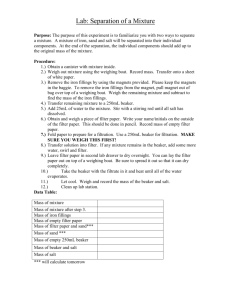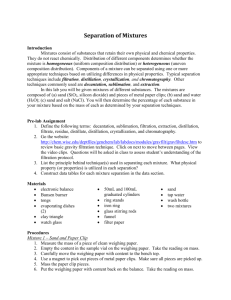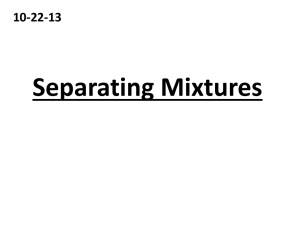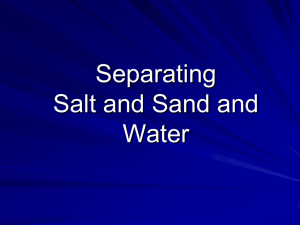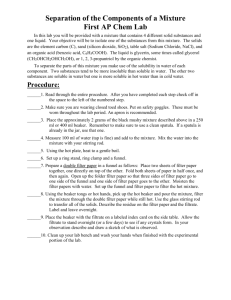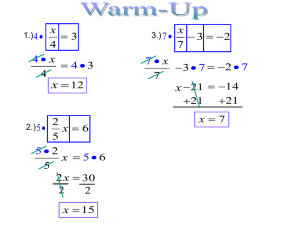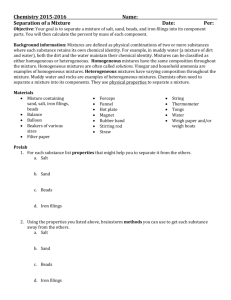Separation of Mixtures
advertisement
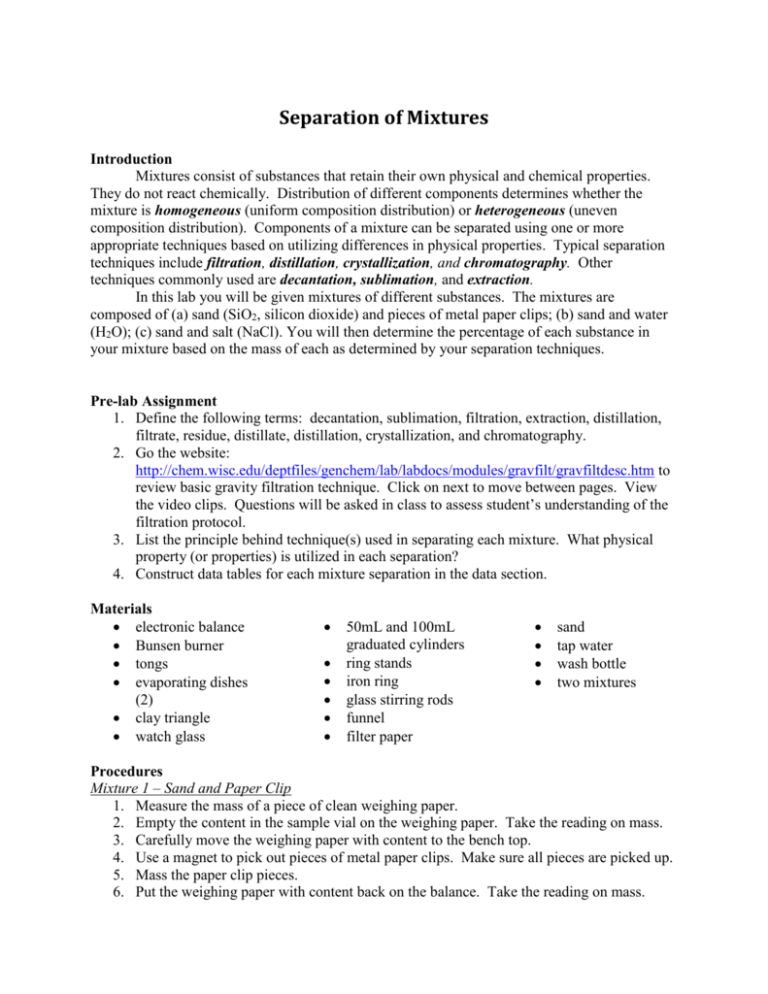
Separation of Mixtures Introduction Mixtures consist of substances that retain their own physical and chemical properties. They do not react chemically. Distribution of different components determines whether the mixture is homogeneous (uniform composition distribution) or heterogeneous (uneven composition distribution). Components of a mixture can be separated using one or more appropriate techniques based on utilizing differences in physical properties. Typical separation techniques include filtration, distillation, crystallization, and chromatography. Other techniques commonly used are decantation, sublimation, and extraction. In this lab you will be given mixtures of different substances. The mixtures are composed of (a) sand (SiO2, silicon dioxide) and pieces of metal paper clips; (b) sand and water (H2O); (c) sand and salt (NaCl). You will then determine the percentage of each substance in your mixture based on the mass of each as determined by your separation techniques. Pre-lab Assignment 1. Define the following terms: decantation, sublimation, filtration, extraction, distillation, filtrate, residue, distillate, distillation, crystallization, and chromatography. 2. Go the website: http://chem.wisc.edu/deptfiles/genchem/lab/labdocs/modules/gravfilt/gravfiltdesc.htm to review basic gravity filtration technique. Click on next to move between pages. View the video clips. Questions will be asked in class to assess student’s understanding of the filtration protocol. 3. List the principle behind technique(s) used in separating each mixture. What physical property (or properties) is utilized in each separation? 4. Construct data tables for each mixture separation in the data section. Materials electronic balance Bunsen burner tongs evaporating dishes (2) clay triangle watch glass 50mL and 100mL graduated cylinders ring stands iron ring glass stirring rods funnel filter paper sand tap water wash bottle two mixtures Procedures Mixture 1 – Sand and Paper Clip 1. Measure the mass of a piece of clean weighing paper. 2. Empty the content in the sample vial on the weighing paper. Take the reading on mass. 3. Carefully move the weighing paper with content to the bench top. 4. Use a magnet to pick out pieces of metal paper clips. Make sure all pieces are picked up. 5. Mass the paper clip pieces. 6. Put the weighing paper with content back on the balance. Take the reading on mass. 7. Clean up. Mixture 2 – Sand and Water 1. Carefully measure ~ 2.00 grams of sand on the electronic balance and put in a 150-mL beaker. 2. Use proper graduated cylinder to measure 50.0 mL tap water. 3. Pour the water into the 150-mL beaker. 4. Stir with a glass rod for 2 minutes. Then stop the agitation and observe. 5. Mass a piece of filter paper. 6. Prepare the filtration setup as shown on the website (see link above) with the massed filter paper. 7. Filter the sand/water mixture. Make sure the liquid level does not exceed the edge of the filter paper. 8. Use small amount of water from the wash bottle to wash sand residue in the beaker to the filter paper. 9. Use small amount of water from the wash bottle to wash the sand residue on the filter paper three times and collect the filtrate. Let the liquid completely drain. 10. Put the filter paper along with the residue in a beaker with proper labeling. 11. Put the beaker with filter paper and residue in a fume hood to dry overnight. 12. Come the next day to take the mass of residue plus the filter paper. 13. Clean up. Mixture 3 – Sand and Salt 1. Mass the clean watch glass and empty evaporation dish. 2. Put a piece of weighing paper on the balance and zero it. 3. Pour the mixture from the sample vial on the weighing paper and take the mass reading. 4. Carefully transfer the solid contents to a clean 150-mL beaker. 5. Add 30 mL water to the beaker and stir with a glass rod for 3 minutes. Then let the mixture sit for 5 minutes. 6. Mass a filter paper. 7. Set up filtration the same as in in mixture 2. 8. Filter the mixture and transfer all content onto the filter paper. Let it drain completely. 9. Use small amount of water from the wash bottle to wash the residue on the filter paper two more times. Collect all portions of filtrate. 10. Transfer the filtrate to a clean evaporation dish. Fill maximum to the half of the evaporation dish. 11. Put the watch glass on top of the evaporation dish. 12. Set up Bunsen burner to evaporate water in the filtrate mixture. Note: splashing will be inevitable occur. Make sure the watch glass in on top of the evaporation dish. 13. After the water is completely driven out of the sample, let the evaporation dish and the salt cool down on a wire-gauze. 14. Mass the evaporation dish. 15. Put the filter paper with residue in a carefully labeled beaker. Note: has to make clear distinction from mixture 2. Put the beaker into a fume hood to dry overnight. 16. Come in the next day to take the mass of the residue plus the filter paper. 17. Clean up. Data: Mixture 1 – Sand and Paper Clip Qualitative Data (general observations) Quantitative Data (measurements) Data Table 1 Mixture 2 – Sand and Water Qualitative Data (general observations) Quantitative Data (measurements) Data Table 2 Mixture 3 – Sand and Salt Qualitative Data (general observations) Quantitative Data (measurements) Data Table 3 Data Analysis: Mixture 1 – Sand and Paper Clip How is the mixture classified? What is the mass for the sand? What is the mass for the paper clips? What is the percent of paper clips in the sample? Compare with the actual percent of paper clips in the sample, what is the percent error with this measurement? Mixture 2 – Sand and Water How is the mixture classified? What is the mass of dried sand after filtration? What is the percent error associated with this activity, comparing the residual sand mass with the initial mass of dry sand? Mixture 3 – Sand and Salt What is the mass of the sand? Show work on the process. What is the mass of the salt? Show work on the process. What is the percent of salt in the mixture? Compare with the actual salt content in the sample, what is the percent error with this measurement? Conclusions and Discussions: Post-lab Questions: 1. Calculate % error for all measurements where expected values are provided. Explain any discrepancy in error analysis section. 2. If given a mixture composed of paper clips, sand and salt and tasked with quantifying % composition for each component, propose a detailed procedure. 3. If given a mixture composed of paper clips, ammonium chloride crystals, sand and salt and tasked with quantifying % composition for each component, propose a detailed procedure. What have you learned in this lab?
